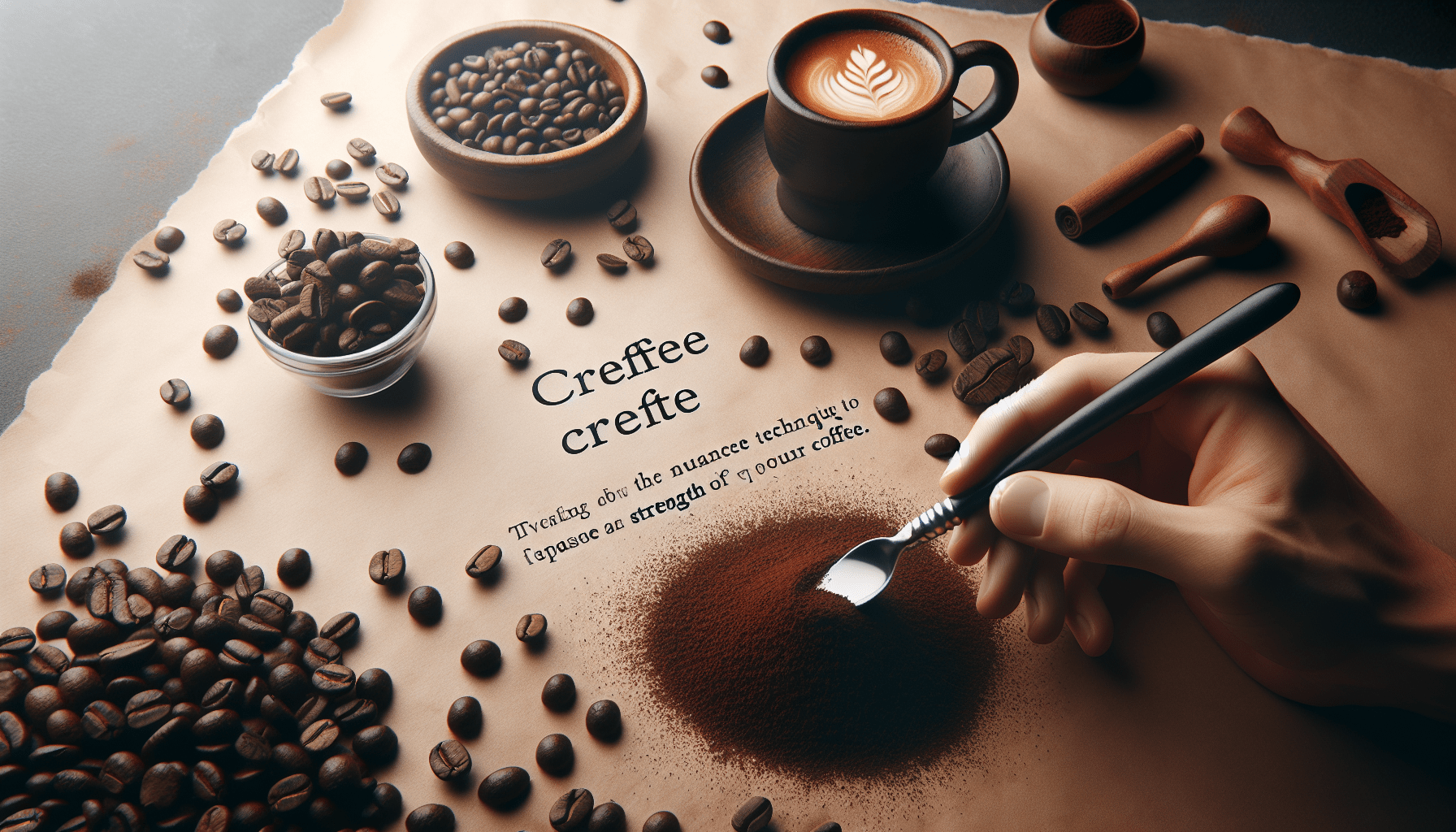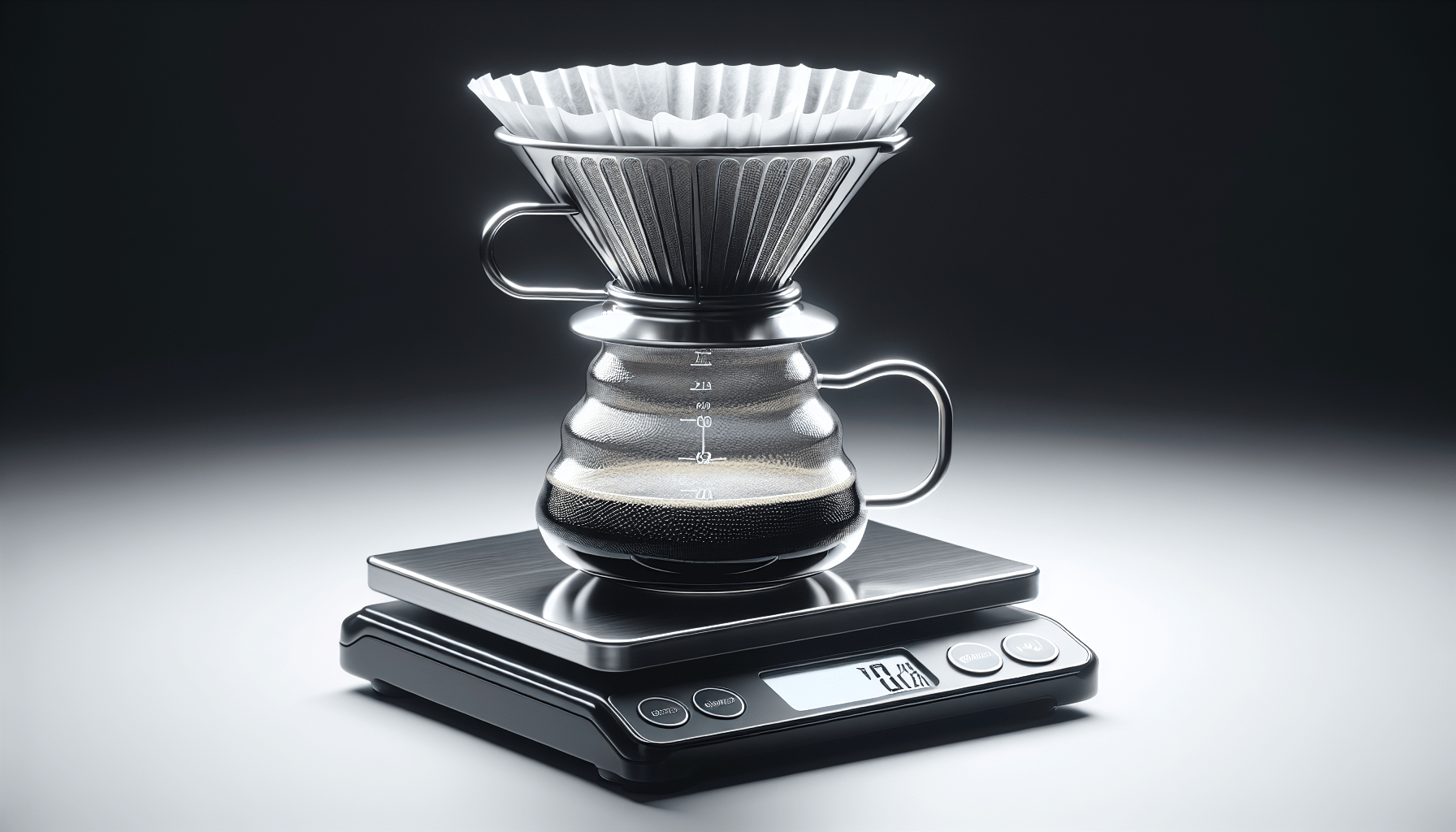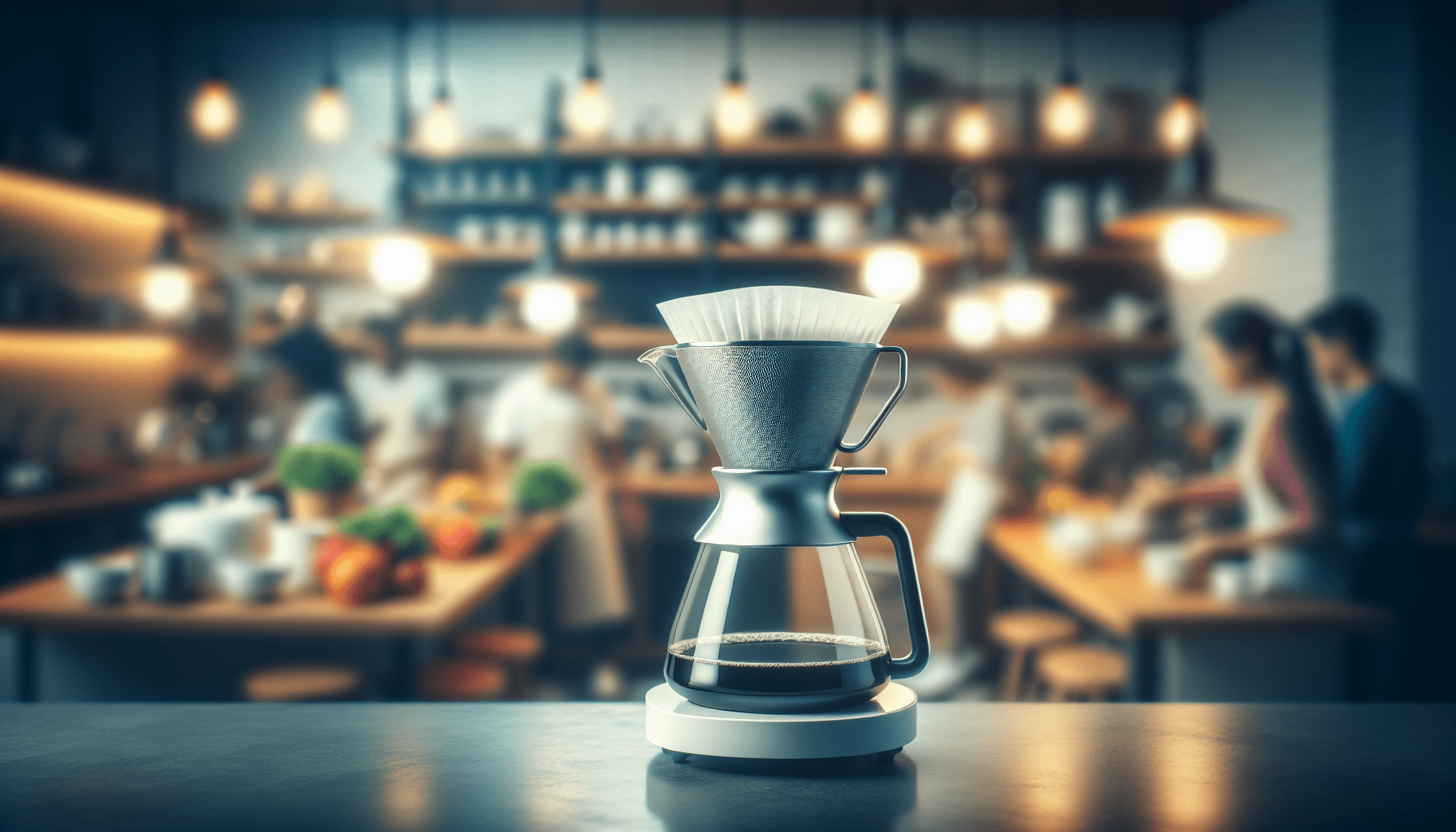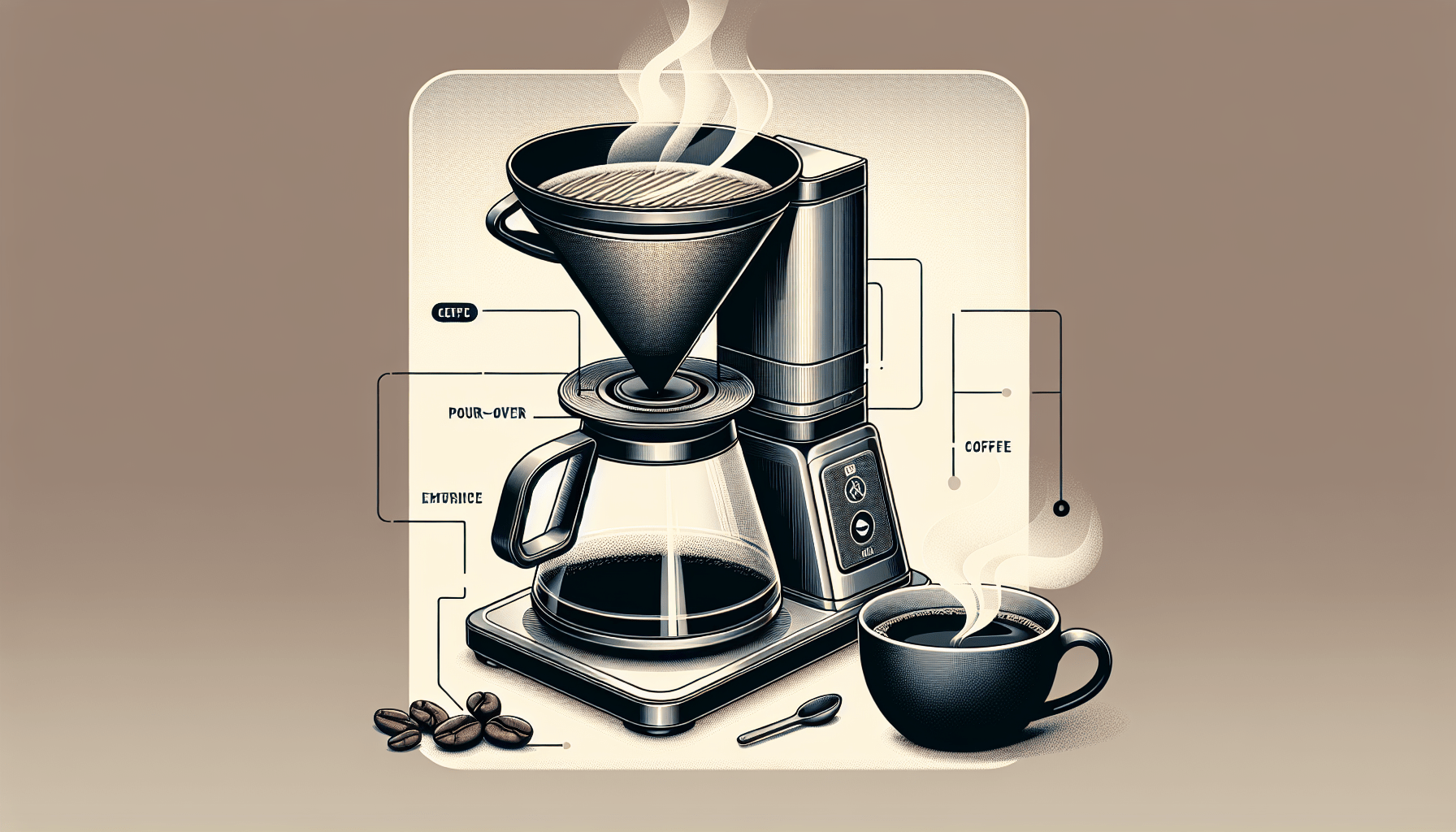In the world of coffee, finding the perfect balance of strength and flavor is a quest that many hold dear. If you’re the kind of person who craves a customizable cup of joe, then you might be wondering if a pour-over coffee maker is the way to go. Well, good news! With a pour-over coffee maker, you have the power to adjust the strength of your brew to your liking. Gone are the days of settling for a one-size-fits-all approach to your morning caffeine fix. Let’s explore how you can have full control over the strength of your coffee with a pour-over coffee maker.
Understanding Pour-over Coffee
What is pour-over coffee?
Pour-over coffee is a brewing method that involves manually pouring hot water over coffee grounds, allowing the water to slowly drip through a filter into a cup or carafe. This method requires a pour-over coffee maker, which typically consists of a cone-shaped dripper and a filter. It allows for complete control over the brewing process, resulting in a rich, flavorful, and custom-tailored cup of coffee.
Why is it popular?
Pour-over coffee has gained significant popularity in recent years, and for good reason. One of the main appeals of this brewing method is the ability to customize the strength and flavor of your coffee. By adjusting various factors like coffee-to-water ratio, grind size, brewing time, and water temperature, you can fine-tune your brew to suit your personal preferences. Additionally, the pour-over process is often seen as a ritual, allowing coffee enthusiasts to actively participate and enjoy a calming and immersive experience.
How does it differ from other brewing methods?
Compared to other brewing methods like automatic drip machines or French press, pour-over coffee offers several distinct advantages. Firstly, the pour-over method allows for precise control over each brewing variable, ensuring consistent results and the ability to adjust the strength and flavor of the coffee. Additionally, the paper filter used in pour-over coffee removes most of the oils and sediment, resulting in a clean and smooth cup of coffee. Finally, the pour-over process is slow and deliberate, allowing the flavors of the coffee to fully develop and resulting in a more nuanced and aromatic beverage.
Factors Affecting Coffee Strength
Coffee-to-Water Ratio
The coffee-to-water ratio is one of the key factors influencing the strength of your pour-over coffee. This ratio refers to the amount of coffee grounds used relative to the amount of water. A higher ratio will yield a stronger coffee, while a lower ratio will produce a milder brew. Experimenting with different ratios is essential to finding your preferred strength. As a starting point, a common ratio is 1:16, which means using 1 gram of coffee per 16 grams of water. However, it’s important to note that personal preferences may vary, so don’t be afraid to adjust the ratio based on your taste.
Grind Size
The grind size of the coffee beans is another vital factor in determining the strength of your pour-over coffee. A finer grind will result in a stronger extraction, as more surface area of the coffee particles comes into contact with water. Conversely, a coarser grind will yield a milder brew. Finding the right grind size for your pour-over coffee maker is often a matter of trial and error. It’s recommended to start with a medium grind and then adjust finer or coarser based on your desired strength and extraction.
Brewing Time
The brewing time of your pour-over coffee also plays a significant role in determining its strength. The longer the coffee is in contact with hot water, the stronger the extraction will be. Conversely, a shorter brewing time will produce a milder cup of coffee. It’s important to note that brewing time is directly influenced by the rate at which you pour the water over the coffee grounds. For a stronger brew, a slower pour rate is recommended, allowing for a more extended contact time. Conversely, a faster pour rate will result in a faster extraction and a milder coffee.
Water Temperature
Water temperature is a critical variable that impacts the extraction of flavors from the coffee grounds. Too hot, and you risk extracting bitter compounds; too cold, and you may not extract enough flavor. The optimal temperature for pour-over coffee is generally considered to be between 195°F (90°C) and 205°F (96°C). However, you can modify the temperature based on your desired strength. For a stronger coffee, using water at the higher end of the temperature range may enhance extraction, while a lower temperature may result in a milder cup.
Controlling Coffee Strength with Pour-over Coffee Maker
Adjusting Coffee-to-Water Ratio
One of the easiest ways to control the strength of your pour-over coffee is by adjusting the coffee-to-water ratio. If you prefer a stronger brew, try increasing the amount of coffee grounds while keeping the water amount constant. On the other hand, for a milder cup, decrease the coffee grounds while maintaining the same water volume. It’s important to note that changes in the ratio will likely affect the overall flavor profile of your coffee, so it’s essential to find the right balance between strength and taste.
Experimenting with Grind Size
Grind size significantly impacts the extraction rate and, consequently, the strength of your coffee. If you find your brew to be too weak, try grinding your coffee beans finer for increased extraction. Conversely, if your coffee is too strong, a coarser grind can reduce the extraction and result in a milder cup. It’s advisable to experiment with different grind sizes to find the sweet spot that aligns with your preferred strength and taste preferences.
Adapting Brewing Time
The duration of the brewing process is directly tied to the strength of your pour-over coffee. By adjusting the pouring rate and the time it takes to pour the water over the coffee grounds, you can control the contact time between the water and the coffee, leading to different extraction levels. If you desire a stronger cup, extending the brew time by pouring the water slowly can enhance the extraction. Conversely, a shorter brewing time achieved through a faster pour will result in a milder brew.
Managing Water Temperature
Water temperature plays a crucial role in the extraction of flavors during the pour-over process. By regulating the water temperature, you can tailor the strength of your coffee to your liking. If you prefer a stronger brew, consider using water at the higher end of the optimal temperature range. Conversely, if you prefer a milder cup, using water at the lower end can reduce the extraction slightly. It’s important to note that water temperature is best measured using a thermometer to ensure accuracy and consistency.
Coffee-to-Water Ratio
Importance of the ratio
The coffee-to-water ratio is a fundamental aspect of pour-over coffee brewing. It determines the strength and the overall flavor profile of your coffee. Finding the right ratio for your taste preferences is crucial for achieving a satisfying cup of coffee. By adjusting the ratio, you can make subtle changes to the strength while retaining a balance between the flavors and the overall taste of the brew.
Different ratios and their impact on strength
Various ratios can be used in pour-over brewing, each resulting in a different strength of coffee. A 1:16 ratio, where 1 gram of coffee is used per 16 grams of water, is a commonly recommended starting point. This ratio typically produces a balanced and milder cup of coffee. However, if you prefer a stronger brew, you can increase the ratio to 1:15 or 1:14. On the other hand, for a milder cup, you can decrease the ratio to 1:17 or 1:18. Experimenting with different ratios is key to finding your perfect strength.
Measuring tools for precision
To attain precision in your pour-over coffee brewing, it’s recommended to use measuring tools. A digital scale can be used to measure both the coffee grounds and the water accurately, ensuring consistency and repeatability. Measuring by weight rather than volume allows for more precise control over the coffee-to-water ratio, resulting in more consistent and predictable strength. Additionally, using a grinder with built-in settings or a separate coffee grinder with adjustable grind sizes can help achieve the desired strength more precisely.
Grinding Coffee Beans
Impact of grind size on strength
Grind size plays a significant role in determining the strength of your pour-over coffee. Finely ground coffee particles have a larger surface area and allow for more efficient extraction. As a result, using a finer grind size will generally lead to a stronger cup of coffee. Conversely, a coarser grind size means less surface area, resulting in a milder extraction. Understanding the impact of grind size on coffee strength is essential to achieve the desired flavor profile and balance.
Finding the right grind size
Determining the ideal grind size for your pour-over coffee maker often requires some experimentation. As a starting point, a medium grind size is generally recommended for most pour-over methods, as it strikes a balance between extraction efficiency and clarity of flavor. However, if you find your coffee to be too weak, try a slightly finer grind. On the other hand, if it is too strong or overly bitter, adjusting to a coarser grind size can help mitigate these effects. Adapting the grind size based on your preferences will allow you to fine-tune the strength of your coffee.
Recommended grind sizes for pour-over coffee
While personal preferences may vary, there are some general guidelines for grind sizes that work well with pour-over coffee. For a beginner-friendly approach, a medium grind is often recommended, as it strikes a balance between extraction and flavor clarity. As you become more familiar with the brewing process, you can experiment with finer grind sizes, such as a medium-fine grind. This can result in a stronger, more full-bodied cup of coffee. However, it’s important to note that different pour-over devices may require slight adjustments in grind size, so it’s advisable to refer to the manufacturer’s recommendations or experiment to find the optimal grind size for your specific equipment.
Brewing Time
Relation of time and coffee strength
The brewing time directly affects the strength of your pour-over coffee. The longer the coffee is in contact with water, the more time there is for extraction to take place, leading to a stronger brew. Conversely, a shorter brewing time will result in a milder cup of coffee. By adjusting the speed at which you pour the water, you can control the contact time, hence impacting the overall strength and flavor of your brew.
Adjusting brew time for desired strength
To tailor the strength of your pour-over coffee to your liking, you can adjust the brewing time. For a stronger cup, pour the water slowly, allowing for a longer contact time. This slower pour rate will result in a more thorough extraction, making the coffee stronger. On the other hand, for a milder brew, increase the pour rate, reducing the overall contact time between water and coffee grounds. It’s important to note that brewing time, along with other variables like grind size and water temperature, should be adjusted collectively to maintain the desired flavor profile.
Common time ranges for pour-over brewing
The optimal brewing time for pour-over coffee can vary depending on factors like grind size, coffee-to-water ratio, and personal preference. However, there are some common time ranges that can serve as a starting point. In general, a brewing time of 2 to 4 minutes is often recommended for pour-over coffee. Keep in mind that a coarser grind will generally require a longer brewing time, while a finer grind may necessitate a shorter one. Experimenting with different brewing times within this range will help you find the perfect balance of strength and flavor for your pour-over brew.
Water Temperature
Effect of temperature on extraction
The water temperature used in pour-over coffee brewing significantly impacts the extraction of flavors from the coffee grounds. Hot water acts as a solvent, breaking down the compounds in the coffee to extract the desired flavors. If the water temperature is too low, the extraction may be insufficient, resulting in a weak and underwhelming cup of coffee. Conversely, if the water is too hot, more unwanted compounds like bitterness may be extracted, leading to an overly strong or even unpleasant brew.
Optimal temperature for pour-over coffee
The optimal water temperature for pour-over coffee is generally considered to be in the range of 195°F (90°C) to 205°F (96°C). Within this range, the water is hot enough to extract the coffee’s flavors effectively without introducing excessive bitterness. However, it’s essential to note that personal preferences may differ, and some experimentation may be necessary to find the ideal temperature for your desired strength. Using a digital thermometer to measure the water temperature accurately can help ensure consistency and repeatability in your pour-over brewing process.
Modifying temperature based on desired strength
If you wish to adjust the strength of your pour-over coffee, you can modify the water temperature within the recommended range. For a stronger brew, consider using water at the higher end of the temperature range, as this can enhance extraction. On the other hand, if you prefer a milder cup, using water at the lower end can help reduce extraction slightly. It’s important to remember that water temperature is just one of the factors affecting coffee strength, and adjustments should be made in conjunction with other variables like grind size and brewing time to achieve the desired flavor profile.
Fine-tuning the Strength
Combining multiple factors
To truly fine-tune the strength of your pour-over coffee, it’s essential to consider multiple factors and how they interplay with each other. Adjusting the coffee-to-water ratio, grind size, brewing time, and water temperature collectively can help you achieve the perfect balance of strength and flavor. By experimenting with different combinations of these variables, you can discover the ideal brewing parameters that align with your personal taste preferences.
Keeping a brewing journal
A brewing journal can be a valuable tool in fine-tuning the strength of your pour-over coffee. Keeping track of the variables and adjustments you make during each brewing session allows you to identify trends and patterns. Note down the coffee-to-water ratio, grind size, brewing time, and water temperature for each brew and record your impressions of the strength and flavor. Over time, you can refer back to your journal to replicate the brews you enjoy the most or make further adjustments based on your preferences.
Iterating to achieve preferred strength
Achieving your preferred strength of pour-over coffee often involves a process of iteration. As you experiment with the various factors and measure the resulting strength and flavor, you can make incremental adjustments to bring the brew closer to your desired taste. Fine-tuning takes time, patience, and a willingness to try different combinations. By embracing the process and understanding that each adjustment brings you one step closer to your preferred strength, you’ll ultimately reach a satisfying and personalized cup of pour-over coffee.
Experimenting with Pour-over Techniques
Alternative pouring methods
While the classic pour-over technique is popular and effective, there are alternative pouring methods that can introduce new flavors and nuances to your brew. For example, the “pulse pour” method involves pouring the water in multiple small stages rather than a continuous slow pour. This technique can help accentuate certain flavor characteristics and alter the strength of the coffee. Similarly, the “Japanese iced coffee” method, where hot water is directly poured over ice cubes, can yield a different strength and flavor profile compared to traditional hot pour-over brewing. Exploring these alternative pouring methods can add excitement and variety to your pour-over coffee experience.
Specialty equipment for nuanced extraction
If you’re seeking to dive deeper into the world of pour-over coffee and experiment with precision extraction, specialty equipment can be a valuable addition to your brewing arsenal. Tools like gooseneck kettles provide greater control over the flow and direction of the water, allowing for more precise pouring techniques. Additionally, investing in a high-quality burr grinder with adjustable grind sizes can further enhance the control over your brew’s strength. While not essential for every pour-over enthusiast, these specialty tools can offer more advanced techniques and refine the strength of your coffee to the finest details.
Exploring advanced pour-over recipes
Once you’ve mastered the foundation of pour-over coffee brewing, you may want to explore advanced recipes and techniques. Coffee enthusiasts and professionals often share their innovative approaches to pour-over brewing, offering unique flavor profiles and strength variations. Some recipes may involve intricate pouring patterns, multiple stages of brewing, or incorporating different water ratios at specific intervals. Exploring these advanced recipes can provide inspiration and expand your understanding of how different techniques and combinations of factors can influence the strength and flavor of your pour-over coffee.
Tips for Consistency and Reproducibility
Maintaining consistency in coffee strength
Consistency is key to achieving the desired strength in your pour-over coffee. To ensure consistent results with each brew, it’s essential to maintain a standard approach to your brewing process. This includes using accurate measuring tools, recording the variables and adjustments made, and adhering to the preferred ratio, grind size, brewing time, and water temperature. By minimizing variables and following a consistent routine, you can reproduce the strength and flavor profile you enjoy.
Documenting adjustments for future reference
To maintain consistency and facilitate future adjustments, it’s helpful to document the changes you make during each brewing session. Whether it’s in a physical journal, a digital note-taking app, or a dedicated coffee brewing app, recording the specific modifications made to your pour-over process allows you to refer back to successful brews and determine which adjustments contributed to the achieved strength. As you learn more about your preferences, having a reliable record of past adjustments becomes invaluable in reproducing your preferred strengths consistently.
Mastering the pour-over technique
Mastering the pour-over technique requires practice, patience, and attention to detail. From the pour rate to the circular motion of the pour to the even saturation of the coffee grounds, each step plays a role in determining the strength and flavor of your brew. Consistent practice will help hone your pouring skills and allow you to achieve a consistent flow rate and extraction throughout the brewing process. With time and experience, you’ll develop a level of mastery that empowers you to control the strength of your pour-over coffee with precision.




